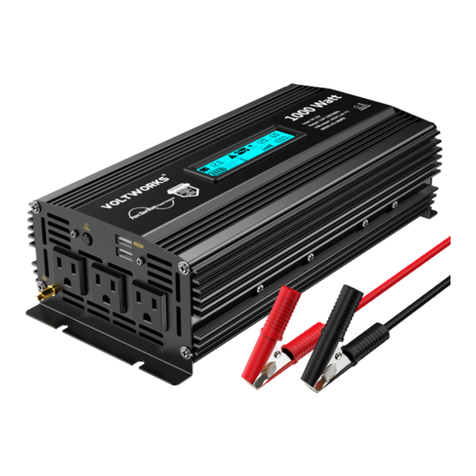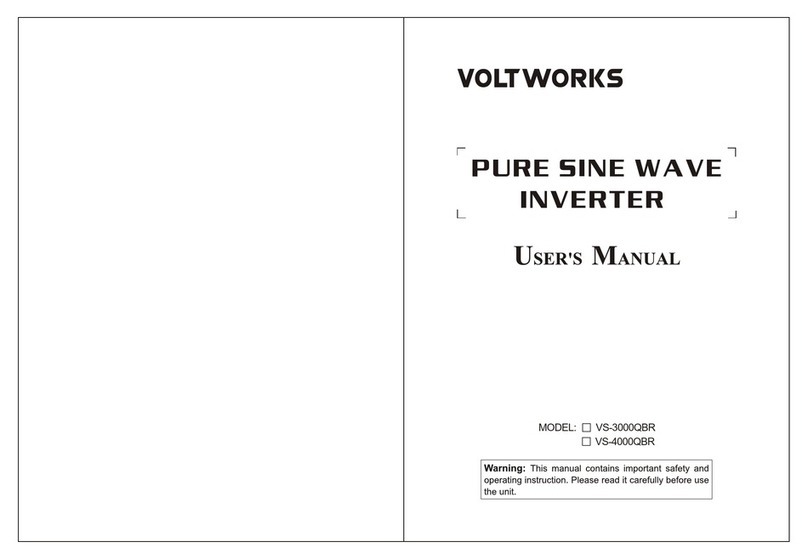
At the same time, the battery must provide enough current for inverter, a small capacity
battery is not able to drive high power appliances, in this case, usually due to excessive
current and battery discharge the battery terminal voltage low, under voltage protection
products appear.
The simple formula for the battery current is the load power / the battery voltage. As the
inverter itself will be part of the loss, so the actual current will be greater than this value
of about 10%. For example: the battery voltage is 12VDC, the load power is 1000W,
then the actual current size of the battery is about 1000W÷12V×110%=91.6A
2) Battery working time
The using time of battery depends on battery capacity (AH) and the power of the
connected load (W), the calculating method is: Time (hours) =battery capacity (AH) x
battery output voltage (V) x efficiency rate ÷ electrical power of using (W) such as the
12V DC input inverter uses the 12V battery, if the battery capacity is 2000AH and at this
time the inverter is driving 1000W power load, the efficiency rate is 90% when the
battery is full, according to the formula above, the battery use time =2000(AH) / (1000 /
12x110%) = 21.8 (Hour). This means the battery can be used for 21.8 hours.
Note: The above formula is the calculation result of the battery discharging rate in 20
hours, that is, when the discharging current of 2000 Ah battery does not exceed 100A,
the discharging time will be shortened when the discharging current exceeds this value.
This part can refer to the battery manufacturer's specifications, and whether the battery
is fully charged will also affect this result.
6. CONNECTION
1) Grounding
The power inverter has a terminal on the back panel marked "Grounding" or " ". This
is used to connect the chassis of the power inverter to the ground. The ground terminal
has already connected to the ground wire of AC output receptacle through the internal
connecting wire. The ground terminal must be connected to the ground wire, which will
vary depending on where the power inverter is installed. In a vehicle, connect the
ground terminal to the chassis of the vehicle. On the ship, connect the ground terminal
to the ship grounding system; In a fixed position, connect the ground terminal to the
earth.
Warnings:
● To make sure the firmness of the connection. The ground wire must be
2
14AWG(2.08mm )or even larger.
● Do not operate the power inverter without connecting to ground. Electric shock hazard
may result.
2) Connect to the battery
① Please do all the safety precautions before connection, then check whether the battery
voltage is in accordance with the input voltage of the inverter. Only the voltage of
battery according with the requirements can be allowed to connect with the inverter.
5.
② The connecting wire must be big enough to bear current, or else the inverter can not
support big load because of voltage reduce caused by the small cross-sectional wire.
Depending on the below table, please select the input DC wire or larger one.
Notice:
1. The above table is only for your reference. In practice, the thick wire can be replaced by
two thin parallel wires if only the total section acreage of the wire meets the
requirements.
2. In high current, the input DC wire may produce voltage drop, therefore,the operating
voltage should be subject to the value on the terminals. If the voltage drop is too large,
it can increase the acreage of the section or reduce the length of the lead.
3. Connect cathode wire of the battery to the cathode terminal (black) on the back panel of
inverter and then connect the anode wire of the battery to the anode terminal (red)on
the inverter, and fix them.
Warnings:
① Please wear eye patch and work clothes when working around the battery to avoid the
acid and corrosive objects harm your eyes and skin.
② Prepare enough water and soap. In case the acid materials contact eyes or skin, clean
it by soap and water as soon as possible. If the acid materials spay to your eyes
accidentally, clean it by cold water immediately and then sent to hospital.
③ Do not put any combustible material in the location of installation for spark will result
when it is connected to the battery.
④ Keep good ventilation. The battery may produce a little inflammable gas when it works,
so keep away from the inverter and it is better to install them in different space.
⑤ Fix the connecting wire of the input DC, or it will result the over-reduction of the voltage
or over-temperature of the wire.
⑥ Reverse connection of the polarities or the short circuit will burn the fuse or result the
permanence damage of the internal elements of inverter.
⑦ Take away the metal accouterment, such as ring or watch, when installation to avoid
the short circuit.
⑧ Although there is over-voltage protection, it may also cause damage of the inverter if
the input voltage is too high.
3) Connection of the AC appliance
Put the power plug of the AC appliance load into the output AC receptacle of the
inverter directly.
Warnings:
1. Make sure that the switches of the inverter and appliance power are in OFF position
before connection.
2. Check the power cord. If it is damaged, it should be connected after replacement.
4.
12V 1100W
1100W
110A
55A
Inverter Input
voltage Rating power Max current
of cable
Specication of wire length=N m
(Cross section area)
24V
Specification of wire length≤1m
(Cross section area)
2
6AWG (13.3mm )
2
9AWG (6.63mm )
2
N×13.3mm
2
N×6.63mm


























